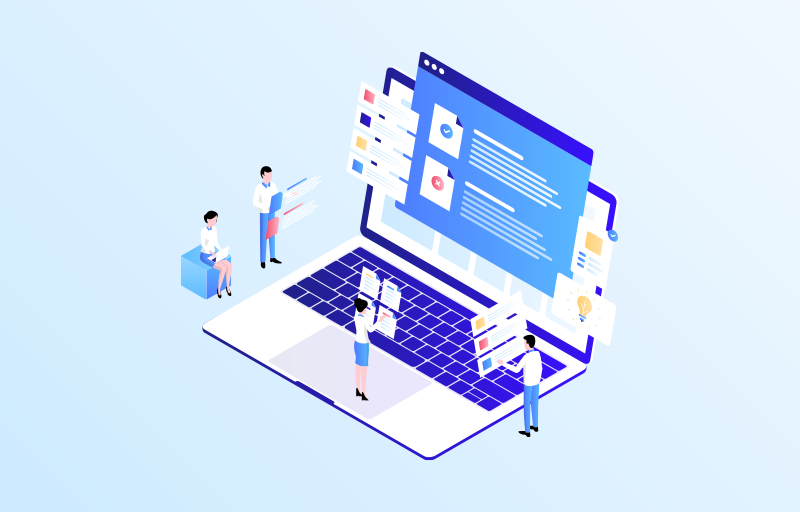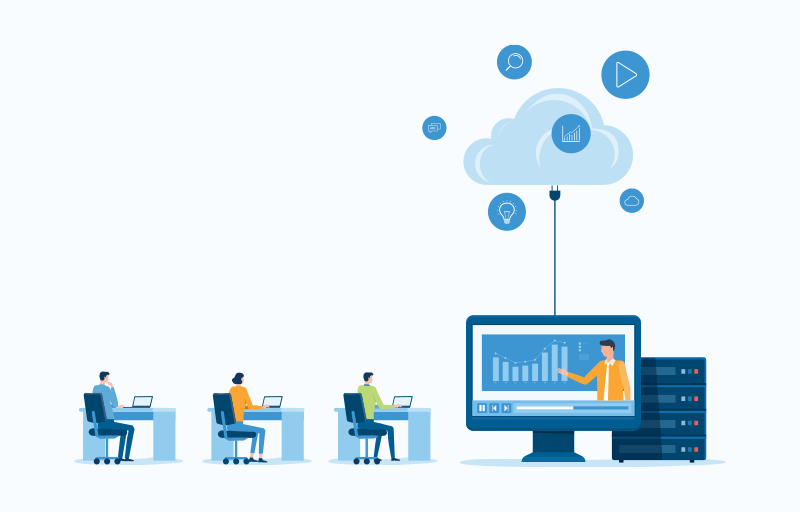Application migration services help organizations to move critical business applications from on premises environments to modern cloud platforms. Whether you need lift and shift migration for quick cloud adoption or comprehensive replatforming for enhanced performance, we deliver solutions that improve system scalability and accelerate your digital transformation. Our migration assessment and strategy approach ensures every project aligns with your business objectives while maintaining security, compliance, and operational continuity.
Our Application Migration Services
We provide end-to-end application migration services designed to modernize legacy systems and seamlessly move workloads to the cloud. Our offerings include re-hosting, re-platforming, and re-architecting apps for AWS, Azure, and Google Cloud. From cloud-native development to hybrid integration, we ensure secure, scalable, and cost-effective migrations that align with your business goals.
Lift and Shift Migration
Move existing applications to cloud infrastructure with minimal code changes. This approach provides immediate cost benefits and improved scalability while preserving current application functionality and user experiences.
Application Replatforming
Optimize applications during migration by updating underlying platforms and services. Take advantage of cloud native features like managed databases, auto scaling, and enhanced security without full application rewrites.
Application Refactoring Projects
Restructure application code and architecture to fully leverage cloud capabilities. Transform monolithic applications into microservices, implement containerization, and optimize for cloud performance and cost efficiency.
Database Migration Solutions
Migrate complex database systems with zero data loss and minimal downtime. Handle everything from simple database moves to complex data transformation and consolidation projects across multiple platforms.
Legacy System Modernization
Transform outdated systems that cannot be directly migrated. We rebuild critical functionality using modern frameworks while preserving business logic and ensuring seamless integration with existing workflows.
Hybrid Cloud Migration
Design and implement hybrid architectures that keep sensitive data on premises while moving appropriate workloads to public cloud. Balance security requirements with cloud benefits through strategic workload placement.
Multi Cloud Migration
Distribute applications across multiple cloud providers to avoid vendor lock in and optimize performance. Implement cloud agnostic architectures that provide flexibility and risk mitigation across different platforms.
Container Migration Projects
Modernize applications using containerization technologies like Docker and Kubernetes. Enable consistent deployment across environments while improving resource utilization and development velocity.
Application Migration Projects by Zymr
Case Studies
Enterprise ERP System Cloud Migration
A manufacturing company needed to migrate their critical ERP system to reduce infrastructure costs and improve global accessibility. Zymr executed a phased migration approach, moving non critical modules first to validate the process. We implemented automated testing for migration validation and established continuous integration and deployment pipelines. The migration reduced operational costs by 35% while improving system performance and enabling 24/7 global access for remote teams.
Project Details →
Case Studies
Financial Services Application Modernization
A regional bank required migration of their legacy loan processing system to meet growing transaction volumes and regulatory requirements. Zymr performed comprehensive application dependency mapping, redesigned the architecture for cloud scalability, and implemented enhanced security controls. The modernized system reduced loan processing time by 60% while achieving full regulatory compliance and handling 3x the transaction volume.
Project Details →
Case Studies
Healthcare Platform Cloud Transformation
A healthcare provider needed to migrate patient management systems while maintaining HIPAA compliance and zero downtime requirements. Zymr developed a detailed migration roadmap with extensive risk mitigation strategies, implemented secure data migration processes, and established comprehensive monitoring systems. The migration improved system availability to 99.9% while reducing IT maintenance costs by 40% and enabling new telemedicine capabilities.
Project Details →
Benefits of Migrating Apps to the Cloud
Migration costs depend on multiple factors including application complexity, infrastructure requirements, and scope of modernization needed.
Reduce operational costs through optimized resource utilization and eliminating hardware maintenance
Improve business agility with faster deployment cycles and scalable infrastructure that adapts to demand
Enhance system scalability to handle growth without major infrastructure investments
Achieve faster time to market for new features and services through modern development practices
Minimize downtime risks with built in redundancy and disaster recovery capabilities
Access advanced security features and compliance tools available in cloud platforms
Enable global accessibility and remote work capabilities for distributed teams
Leverage artificial intelligence and machine learning services for enhanced functionality
Connect with our experts.
Start now

Why Choose Us for Application Migration
Choosing us means partnering with a trusted leader in cloud migration and application modernization. We bring proven frameworks, certified cloud engineers, and industry-specific expertise to every project. With a focus on zero downtime, regulatory compliance, and future-ready scalability, we deliver smooth migrations that accelerate digital transformation and reduce IT complexity.
- Proven expertise in enterprise application migration across diverse industries and technology stacks
- Comprehensive approach covering assessment, planning, execution, and post migration optimization
- Deep knowledge of major cloud platforms including AWS, Azure, and Google Cloud Platform
- Risk focused methodology that minimizes business disruption and ensures successful outcomes
- Experienced teams in legacy system modernization and complex data migration challenges
- Transparent communication with detailed project tracking and regular milestone reviews
- Long term partnership approach with ongoing support and continuous optimization services
Our Migration Process
Our structured app migration process starts with in-depth assessment and dependency mapping, followed by careful planning to avoid disruptions. We then re-host, refactor, or re-platform applications using automation, CI/CD pipelines, and cloud-native tools. Post-migration, we provide performance optimization, monitoring, and governance to ensure long-term stability and value realization.
1
Migration Assessment and Strategy Development
We begin with comprehensive analysis of your current application landscape, dependencies, and business requirements. Our teams evaluate technical feasibility, identify potential risks, and develop detailed migration roadmaps that align with your strategic objectives and budget constraints.
2
Application Dependency Mapping and Analysis
Our specialists document all application dependencies, data flows, and integration points to ensure complete migration planning. We identify critical path items, potential bottlenecks, and optimization opportunities that inform our migration approach and timeline development.
3
Migration Planning and Architecture Design
We create detailed migration plans including infrastructure requirements, security configurations, and performance optimization strategies. Our cloud architecture designs leverage best practices for scalability, security, and cost optimization while meeting your specific business needs.
4
Proof of Concept and Pilot Migration
Before full scale migration, we execute pilot projects to validate our approach and identify any unexpected challenges. These proof of concept initiatives allow us to refine our methodology and ensure smooth execution of the complete migration project.
5
Data Migration Strategy and Execution
Our data migration specialists handle complex data transformation, validation, and synchronization requirements. We implement secure transfer protocols, establish data integrity checks, and provide rollback capabilities to ensure zero data loss throughout the process.
6
Application Testing and Validation
We conduct comprehensive testing including functionality verification, performance benchmarking, and security validation. Our automated testing frameworks ensure migrated applications meet or exceed original performance specifications while taking advantage of cloud capabilities.
7
Go Live Support and Monitoring
During migration cutover, our teams provide 24/7 support to address any issues immediately. We implement comprehensive monitoring systems to track application performance, user experience, and system stability throughout the transition period.
8
Post Migration Optimization and Support
After successful migration, we continue optimizing applications for cloud performance and cost efficiency. Our ongoing support includes performance tuning, security updates, and recommendations for leveraging additional cloud services that can benefit your business.
Timelines for Application Migration
Migration timelines vary significantly based on application complexity, data volumes, and business requirements.

Simple Application Migration
Straightforward lift and shift migrations for applications with minimal dependencies typically complete within 2 to 3 months. These projects include basic applications, small databases, and standard integrations that require minimal modifications.

Complex Enterprise Migration
Large scale enterprise applications with extensive dependencies, custom integrations, and complex data structures usually require 4 to 8 months for complete migration. Timeline depends on the number of applications, data transformation requirements, and testing complexity.

Legacy System Modernization
Projects involving significant application refactoring, architecture changes, or technology platform updates can take 6 to 12 months or longer. These initiatives require extensive planning, development work, and thorough testing to ensure successful outcomes.

Factors Affecting Timeline
Key variables include application complexity, data volume and structure, number of integrations, compliance requirements, testing scope, and business availability for validation activities. Our assessment process provides accurate timeline estimates based on your specific circumstances.
App Migration Cost
Migration costs depend on multiple factors including application complexity, infrastructure requirements, and scope of modernization needed.
Basic Migration Projects
Simple lift and shift migrations with minimal modifications typically range from $15,000 to $35,000 per application. These projects focus on moving existing functionality to cloud infrastructure without significant changes to application architecture or features.
Comprehensive Migration Solutions
Complex migrations involving application refactoring, database optimization, and integration updates generally range from $50,000 to $150,000 depending on scope and requirements. These projects deliver enhanced performance and take full advantage of cloud capabilities.
Enterprise Transformation Projects
Large scale migrations involving multiple applications, extensive modernization, and complex integration requirements are quoted individually based on detailed assessment. Investment levels reflect the scope of transformation and long term business value delivered.
Cost Optimization Benefits
While initial migration requires investment, most organizations see 25% to 45% reduction in ongoing operational costs within the first year. Cloud infrastructure typically costs less than maintaining on premises hardware while providing superior performance and capabilities.
We begin every engagement with a comprehensive assessment to provide detailed, transparent cost estimates with clear breakdown of all project components and expected return on investment.
FAQ
Application Migration
How do you handle data security during migration?
Answered by: Chief Security Officer
"Data security is our top priority throughout every migration project. We use encrypted transfer protocols, implement access controls, and maintain detailed audit trails for all data movement. Our process includes comprehensive security assessments, vulnerability testing, and compliance validation. For highly sensitive data, we often recommend hybrid approaches or private cloud solutions that provide additional security layers while still delivering cloud benefits."
What are the common challenges in application migration?
Answered by: Senior Migration Architect"The most frequent challenges include discovering undocumented dependencies, handling legacy code that doesn't adapt well to cloud environments, and managing data consistency during large scale transfers. Network latency and bandwidth limitations can also impact migration timelines. Our assessment process specifically looks for these potential issues so we can plan mitigation strategies before they become problems."
Can legacy applications be migrated without major code changes?
Answered by: Application Modernization Specialist"Many legacy applications can be migrated using lift and shift approaches with minimal code modifications. However, the decision depends on the specific technology stack, dependencies, and your long term objectives. Sometimes modest refactoring provides significant benefits in performance and cost optimization. Our assessment process evaluates each application individually to recommend the most appropriate migration approach."
How do you ensure zero downtime during migration?
Answered by: Migration Program Director"Zero downtime requires careful planning and phased execution strategies. We typically implement parallel environments where the new system runs alongside the existing one until we verify complete functionality. Database synchronization, traffic routing, and rollback procedures are all planned in advance. For critical systems, we often perform migrations during planned maintenance windows and use blue green deployment strategies to minimize any service interruption."
Which cloud platforms do you support for migration?
Answered by: Cloud Solutions Lead"We have deep expertise across all major cloud platforms including Amazon Web Services, Microsoft Azure, and Google Cloud Platform. We also support hybrid and multi cloud architectures depending on your business requirements. Our platform recommendations are based on your specific needs including compliance requirements, existing technology investments, and long term strategic goals."
Why should I migrate my applications to the cloud?
Answered by: Digital Transformation Consultant"Cloud migration offers compelling business benefits including reduced infrastructure costs, improved scalability, enhanced security capabilities, and access to advanced services like artificial intelligence and analytics. Most importantly, cloud platforms enable business agility allowing you to respond quickly to market changes and scale operations efficiently. The question isn't whether to migrate, but how to do it strategically to maximize these benefits while minimizing risks."
Let's Connect
Ready to accelerate your digital transformation through strategic application migration?
.png)
Jay Kumbhani
AVP of Software Engineering, Zymr
Consultation with our migration experts to assess your current environment and develop a customized roadmap for cloud success. Contact Zymr to begin your migration journey with confidence.






.svg)
.svg)
.svg)
.svg)
.svg)
.svg)